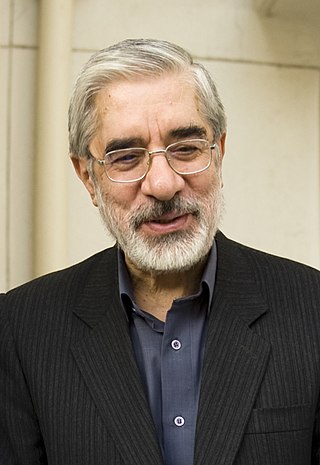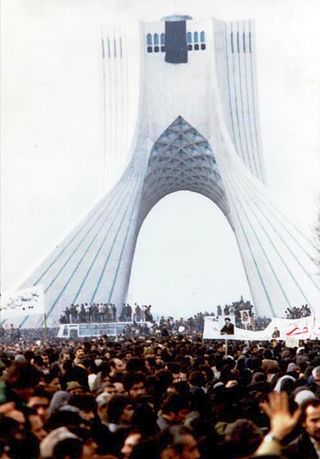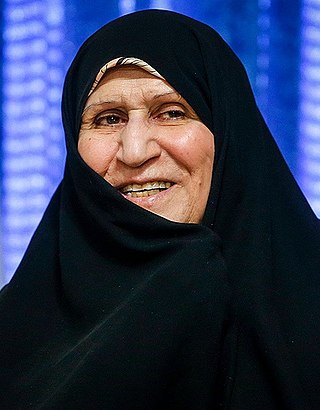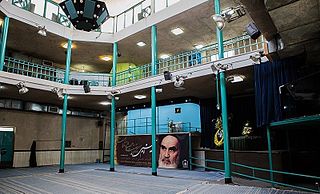
Ruhollah Musavi Khomeini was an Iranian Islamic revolutionary, politician and religious leader who served as the first Supreme Leader of Iran from 1979 until his death in 1989. He was the founder of the Islamic Republic of Iran and the main leader of the Iranian Revolution, which overthrew Mohammad Reza Pahlavi and ended the Iranian monarchy. Ideologically a Shia Islamist, Khomeini's religious and political ideas are known as Khomeinism.

Grand Ayatollah Hussein-Ali Montazeri was an Iranian Shia Islamic theologian, Islamic democracy advocate, writer, and human rights activist. He was one of the leaders of the Iranian Revolution and one of the highest-ranking authorities in Shīʿite Islam. He was once the designated successor to the revolution's Supreme Leader, Ayatollah Khomeini; they had a falling-out in 1989 over government policies that Montazeri claimed infringed on people's freedom and denied them their rights, especially after the 1988 mass execution of political prisoners. Montazeri spent his later years in Qom and remained politically influential in Iran but was placed in house arrest in 1997 for questioning "the unaccountable rule exercised by the supreme leader", Ali Khamenei, who succeeded Khomeini. He was known as the most knowledgeable senior Islamic scholar in Iran, a grand marja of Shia Islam, and was said to be one of Khamenei's teachers.

Mehdi Karroubi is an Iranian Shia cleric and reformist politician leading the National Trust Party. Following 2009–2010 Iranian election protests, Karroubi was put under house arrest in February 2011. As of 2021, he is still confined to his house.

Mir-Hossein Mousavi Khameneh is an Iranian socialist politician, artist, architect and opposition figure who served as the 45th and last Prime Minister of Iran from 1981 to 1989. He was a reformist candidate for the 2009 presidential election and eventually the leader of the opposition in the post-election unrest. Mousavi served as the president of the Iranian Academy of Arts until 2009, when conservative authorities removed him. Although Mousavi had always considered himself a reformist and believed in promoting change within the 1979 constitution, on 3 February 2023, in response to the Mahsa Amini protests, he announced his opposition to the Islamic Republic and asked for a widespread referendum to fully change the constitution and make a fundamental change in Iran's political system.

Mohammad Reyshahri, also known as Mohammad Mohammadi-Nik, was an Iranian politician and cleric who was the first Minister of Intelligence, serving from 1984 to 1989 in the cabinet of Prime Minister Mir-Hossein Mousavi.

The demonstrations of June 5 and 6, also called the events of June 1963 or the 15 Khordad uprising, were protests in Iran against the arrest of Ruhollah Khomeini after his denouncement of Iranian Shah Mohammad Reza Pahlavi and Israel. The Shah's regime was taken by surprise by the massive public demonstrations of support, and although these were crushed within days by the police and military, the events established the importance and power of (Shia) religious opposition to the Shah, and Imam Khomeini as a major political and religious leader. Fifteen years later, Imam Khomeini was to lead the Iranian Revolution which overthrew the Shah and the Pahlavi dynasty and established the Islamic Republic of Iran.

This article is a timeline of events relevant to the Islamic Revolution in Iran. For earlier events refer to Pahlavi dynasty and for later ones refer to History of the Islamic Republic of Iran. This article doesn't include the reasons of the events and further information is available in Islamic revolution of Iran.
al-Musawi is an Islamic title indicating a person descended from Musa al-Kazim, the seventh of the Twelve Shi'a Imams. Family members from this dynasty are amongst the most respected and well-known Muslims. Members of this family are referred to by the anglicized version of their name.

After incumbent president Mahmoud Ahmadinejad declared victory in the 2009 Iranian presidential election, protests broke out in major cities across Iran in support of opposition candidates Mir-Hossein Mousavi and Mehdi Karroubi. The protests continued until 2010, and were titled the Iranian Green Movement by their proponents, reflecting Mousavi's campaign theme, and Persian Awakening, Persian Spring or Green Revolution.
Following the 2009 Iranian presidential election, protests against alleged electoral fraud and in support of opposition candidates Mir-Hossein Mousavi and Mehdi Karroubi occurred in Tehran and other major cities in Iran and around the world starting after the disputed presidential election on 2009 June 12 and continued even after the inauguration of Mahmoud Ahmedinejad as President of Iran on 5 August 2009. This is a timeline of the events which occurred during those protests.

Sayyida Zahra Mostafavi Khomeini is an Iranian politician and educator. The daughter of Ruhollah Khomeini, the leader of the Iranian Revolution and subsequent Supreme Leader of Iran, Mostafavi was awarded a PhD in philosophy from the University of Tehran, where she subsequently taught. Mostafavi has been called the "most prominent" of Khomeini's three daughters, and has become a prominent supporter of women's rights in Iran in addition to Palestinian causes.

The Ashura protests were a series of protests which occurred on 27 December 2009 in Iran against the outcome of the June 2009 Iranian presidential election, which demonstrators claim was rigged. The demonstrations were part of the 2009 Iranian election protests and were the largest since June. In December 2009, the protests saw an escalation in violence.
The 2011–2012 protests in Iran were a series of demonstrations in Iran which began on 14 February 2011, called "The Day of Rage". The protests followed the 2009–2010 Iranian election protests and were influenced by other concurrent protests in the region.
Maryam Shafipour is an Iranian human rights activist. Following seven months of pre-trial detention in Evin Prison, including more than two months in solitary confinement, Shafipour was sentenced in March 2014 to seven years in prison for her political activities. Human rights organization have called for her release and condemned her conviction and prison sentence. She was released in July 2015.

Ruhollah Khomeini’s return to Iran on 1 February 1979, after 14 years in exile, was an important event in the Iranian Revolution. It led to the collapse of the provisional government of Shapour Bakhtiar and the final overthrow of the Shah of Iran, Mohammad Reza Pahlavi, on 11 February 1979.

Jamaran Hussainiya was the house of Imam Ruhollah Khomeini, the founder of the Islamic Republic of Iran, in Jamaran village. On 23 January 1980, Ayatollah Khomeini went to Tehran from Qom to cure a heart ailment. According to doctors recommendation, the weather in Qom did not suit him. The house of Imam Khomeini was next to the Hussainiya in Jamaran village. The house was linked to a large mosque by a metal platform. Imam Khomeini often walked up a flight of stairs leading from his house to the balcony of the mosque, from which he often spoke.
Gholamreza Khoshroo Kuran Kurdieh was an Iranian serial killer known as the Night Bat.
This is a broad timeline of the ongoing series of protests against the government of Iran, sparked by the death of 22-year-old Mahsa Amini on 16 September 2022. Amini had fallen into a coma after having been detained by the Guidance Patrol, allegedly for wearing an "improper" hijab—in violation of Iran's mandatory hijab law—while visiting Tehran from Saqqez.
Armita Abbasi is an Iranian protester, who was arrested on October 10, 2022, in Karaj, Iran by the Islamic Republic of Iran's forces amid Iran's nationwide protests. A week after her arrest, she experienced a serious medical condition that was reported by the hospital medical staff and by American newspaper CNN as multiple sexual assaults, this was later disputed by the Iranian government and Iranian newspapers, which reported the medical condition as intestinal issues. Abbasi was allegedly abducted by government security forces from the hospital. Her case has received attention from the international media, and has brought attention to sexual violence and repression in Iranian prisons. As of February 2023, she was released from prison.











